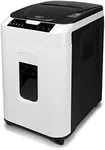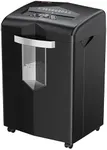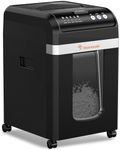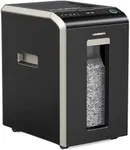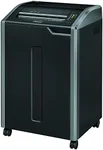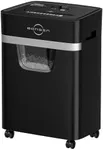Buying Guide for the Best Commercial Paper Shredders
Choosing the right commercial paper shredder is essential for maintaining the security and confidentiality of your business documents. A good shredder can help you dispose of sensitive information safely and efficiently. When selecting a shredder, consider the volume of paper you need to shred, the level of security required, and the features that will make the shredding process easier and more efficient for your business needs.Shred TypeShred type refers to the way the shredder cuts the paper. The main types are strip-cut, cross-cut, and micro-cut. Strip-cut shredders cut paper into long, narrow strips and are suitable for low-security needs. Cross-cut shredders cut paper into small pieces, providing a higher level of security. Micro-cut shredders offer the highest security by cutting paper into tiny particles. Choose a shred type based on the sensitivity of the documents you need to shred.
Sheet CapacitySheet capacity indicates the number of sheets a shredder can handle at once. This is important for efficiency, especially in a busy office. Shredders with a lower sheet capacity (5-10 sheets) are suitable for small offices or occasional use. Medium capacity shredders (10-20 sheets) are ideal for moderate use, while high capacity shredders (20+ sheets) are best for large offices with heavy shredding needs. Consider your office's shredding volume to determine the right sheet capacity.
Run Time and Cool Down TimeRun time is the duration a shredder can operate continuously before needing to cool down. Cool down time is the period the shredder needs to rest before it can be used again. Shredders with longer run times and shorter cool down times are more efficient for high-volume shredding tasks. For occasional use, a shredder with a shorter run time and longer cool down time may suffice. Assess your shredding frequency and volume to choose the appropriate run and cool down times.
Security LevelSecurity level is determined by the size of the shredded particles. The smaller the particles, the higher the security level. Security levels are often categorized from P-1 to P-7, with P-1 being the lowest and P-7 the highest. For general office documents, a P-3 or P-4 level is usually sufficient. For highly confidential documents, consider a P-5 or higher. Determine the sensitivity of the information you need to shred to select the appropriate security level.
Bin CapacityBin capacity refers to the volume of shredded paper the shredder's waste bin can hold. A larger bin capacity means less frequent emptying, which is convenient for high-volume shredding. Small bins (up to 5 gallons) are suitable for low-volume use, medium bins (5-10 gallons) for moderate use, and large bins (10+ gallons) for heavy use. Consider the amount of shredding your office does to choose a bin capacity that minimizes interruptions.
Noise LevelNoise level is an important consideration, especially in a shared office environment. Shredders can vary significantly in how much noise they produce. Quieter models are ideal for maintaining a peaceful work environment. Noise levels are usually measured in decibels (dB). Shredders with noise levels below 60 dB are considered quiet, while those above 70 dB can be quite loud. Consider the noise tolerance of your office when selecting a shredder.
Additional FeaturesAdditional features can enhance the functionality and convenience of a shredder. These may include jam-proof technology, auto-feed capabilities, safety features, and energy-saving modes. Jam-proof technology helps prevent paper jams, auto-feed allows for automatic shredding of stacks of paper, safety features protect users from accidents, and energy-saving modes reduce power consumption. Evaluate which features are most important for your office's needs to choose the best shredder.
